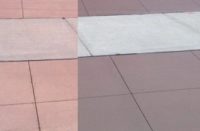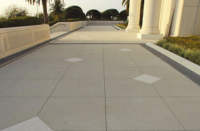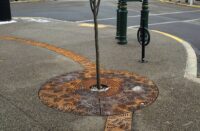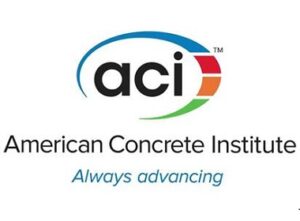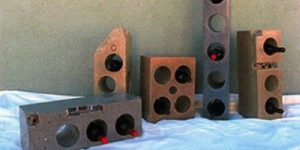Concrete Decor’s first annual Concrete Restoration Contest attracted quality submissions from all over the country. In the end, the four winning entries represented four different ways to approach a concrete restoration job.
When Concrete Decor reviewed the entries, we judged them using three criteria:
- The challenges the contractor faced in rehabbing the project, taking into consideration the state of the original concrete and obstacles that threatened to derail the work along the way.
- The level of creativity that went into the final look of the project.
- The ways in which the look of the restored piece compliments or contrasts with its surroundings, an important element to consider when rehabbing any preexisting concrete feature.
We are thrilled to announce the winners.
Interior: First Place
Premier Veneers, based in Frankfort, Ill., for restoration of an indoor pool patio in Crete, Ill.
While the design elements of this project were not as complex as some other entries, the contractor conquered a number of extraordinary challenges. This entry also shows that sometimes in decorative concrete, imperfections can reflect the emotions of a project and create something that is more powerful.
In The Artist’s Words:
Jeff Donius, Premier Veneers
In October 2005, I was called by the owner of the home, Cindy Hamilton, to do an estimate for the repair of their stamped pool patio, which she said had been installed by their pool contractor but was beset by structural and aesthetic problems, the most notable of which were that it was delaminating throughout and was, on the whole, visibly unappealing.
I went out to do the estimate a couple days later and met with Cindy’s retired husband, John. He took me on a tour of the installation, and I was shocked by what I saw: 1) delamination of large portions of the overlay; 2) alligator cracking in isolated areas due to the use of too much mix water in certain batches of overlay material; 3) the control joints of the original slab were filled with cement instead of being left opened (“honored”); 4) the depth of the overlay was too shallow in many areas, with the original concrete showing through; 5) the overlay covered only part of the interior lip of the pool and terminated with large drip marks in many areas; 6) stamping of the overlay was done at inconsistent depths and in some areas not at all; and 7) accent coloration of the overlay was spotty and much too dark for the light integral color of the overlay.
Unfortunately, John told me that not just the patio but the whole pool project, for two long years, had been fraught with problems. The contractor fixed some of these problems but regarding the patio did not agree there were any problems. So before they did any more damage, John and Cindy told the contractor’s laborers to leave their home. This was just before the overlay was sealed. They then tried to contact the owner of the company to recoup their investment in the patio part of the project. This resulted in a seven-month battle in arbitration. To support their efforts in this regard, I offered to and eventually did write them a notarized letter outlining the problems of the patio installation from a professional standpoint. They eventually recovered some of their money, and grateful for my assistance and impressed by my professionalism, they hired me to do the repair and restoration of their patio.
This project required a complete tear-out of the existing overlay, down to the concrete substrate, and the installation of a new overlay. The added tension of a new overlay on top of the old one would likely only have resulted in further delamination. I started with an indoor-friendly, propane-fueled scarifier to remove the majority of the cement material. This was a major challenge, as I had to navigate the 500-pound machine and vacuum around the edges of the pool without losing control of them into the pool. I then used a 7-inch diamond cup grinder to remove the ridges, fractures, and other remnants of the overlay down to the original concrete, as well as to reach the edges of the overlay, which the scarifier could not. For the interior lip of the pool, I used a rub brick to sand down the drip marks and remove as much material as necessary to reach sound concrete. Next, I recut the original control joints to remove the cement, which had been used to fill them, and I patched and leveled depressions in the concrete caused by scarifying on an uneven andcantilevered slab.
Finally, with every square inch of the patio back down to clean, stable concrete, I could start with the new installation. This entailed a skim coat overlay, followed by a stamped overlay, both from Elite Crete. Cindy chose a simple, Italian slate texture for the body of the overlay and an “autumn ivy” vine pattern to trace the edges of the pool and complement her collection of cactus and plants in the pool room. Both stamps used were by Proline Concrete Tools. I then stained the leaves of the ivy with QC Construction Products’ jade reactive Patina stain, and the background of the floor a “paper bag brown,” achieved by diluting Scofield’s dark walnut, reactive Chemstain. After rinsing and neutralizing the stain residue, and allowing the floor to dry for 48 hours, I sealed with three coats of Elite Crete’s solvent-based acrylic sealer, CSS, broadcasting No. 4 sized glass beads into the second coat for slip resistance.
Cindy and John were ecstatic about the results of their new patio…. But what made the project especially rewarding to me was the friendship I developed with John. You see, the reason John was retired was that he had terminal cancer. When I met him, he had been fighting the disease for two long years, after the doctors had initially only given him months to live. He would overcome the cancer in one area of his body, only to have it surface somewhere else. But he had a great, inspiring, positive attitude about it all. He was grateful that he had been able to do all he wanted to during his life, happy for each day he had left, and his last wish was to resolve the 2-year-long patio problem so that his wife could enjoy it after he was gone. I felt honored and privileged to be able to provide this wish for him. Almost every day, he and I would sit down and have a beer together and reminisce about his life, as another section of overlay material was setting up for stamping, a coat of sealer was drying, or just to take a break. Spending time with and getting to know John was probably the most enjoyable part of the entire project for me. I finished the project just in time for Memorial Day 2006, with Cindy and John planning to entertain friends over the weekend. Sadly, John lost his battle with cancer and passed away just a month later.
www.concreteveneers.com

Interior: Second Place
Polished Concrete Images, a division of K. Johnson Construction Inc., Sauk Rapids, Minn., for the Eich Motor Co. luxury auto dealership showroom in St. Cloud, Minn..
This project is both a classic commercial restoration and an innovative take on restoring a luxury auto showroom floor to showcase quality. By choosing to go with a polished floor, the contractor pursued an environmentally friendly approach to rehab, and the results couldn’t look better.
In The Artist’s Words:
Josh Theis, Polished Concrete Images
This building has a long history as a car dealership. It started out as a Studebaker dealership many years ago. Over the years many additions and remodeling occurred. Throughout the years there was always some type of floor covering over the concrete…. The owner was looking for something that would give them a high-end showroom while preserving the history of dealership. When we brought polished concrete to them as an option, the result wasa beautiful floor that preserved the history of the building while providing a durable flooring solution that would hold up to the traffic of a showroom.
The challenges that we experienced were several different concrete pours over many years, with one addition being poured just prior to the polishing. There were also many cracks, chip-outs from previous walls, and “unlevel” control joints. To correct the cracks and chip-outs we used a patching compound (meadow patch) to fill the voids and then grind them level. In the case of the “unlevel” control joints we ground them level and in extreme cases we had to raise the slab to better level the floor prior to polishing.
To grind and polish the floor we used an HTC 800 HD with diamond tools from HTC. During the process we used Pentra-Sil as our densifier and Pentra Guard as our stain resist. Both of these products are made by Convergent Technologies.
www.pcifloors.com
Exterior: First Place:
Unique Concrete, based in West Milford, N.J., for pool deck restorations in Butler, Greenwood Lake and Lake Denmark, N.J. If concrete restoration means taking a failing slab of concrete and thoroughly restoring it to health, these pool decks are terrific examples.
In The Artist’s Words:
Barry Fisher, Unique Concrete
The resurfacing or restoration of existing concrete surfaces is a cost-effective way to upgrade areas that have failed due to spalling, settling, cracking, and so on, while creating a more decorative appearance at the same time. After we address structural problems, we cover everything with a minimum of 1 1/2 inch of integrally colored, steel-and-fiber-reinforced concrete that we texture and imprint with deep impressions. These impressions are created with our own “cookie-cutter” stamping tools,of which we offer 14 different patterns. The impressions are later grouted. The existing concrete is considered nothing more than a superior sub-base. By not removing it, we are more forgivingto the landscape areas and are less likely to disturb the structural integrity of pools.
The integral color is made with synthetic iron oxides purchased from Lanxess. The synthetic fibers are 3/4-inch and 1 1/2-inch purchased from Nycon. Sealersare purchased from QCConstruction Products. The imprinting tools we make ourselves.
In one project (shown in the top two photos at right), the objective was to eliminate the diving board area and resurface the remaining concrete in a decorative way. By pouring a minimum thickness of 1 1/2 inch and pouring certain areas thickerwhen necessary, we were able to reestablish properpitch over settled and patched areas. We considered the existing concrete to be nothing more than a superior sub-base.
The two photos below them show a second project. Here, the objective was to eliminate the wooden deck on grade and add on to all sides of the pool to create a larger entertaining area. The work produced one continuous visually appealing look without endangering the structural integrity of a 25-year-old pool. The deck was removed and replaced with a concrete slab that corresponded to the height of the existing concrete. Everything was then covered with 1 1/2 inches of integrally coloredfiber and steel-reinforced concrete.
In another project (not shown), the objective was to resurface the existing concrete and old metal coping. The new surface reestablished pitch on areas that didn’t drain well and other areas that had excessive pitch due to settling. All existing concrete was basically structurally sound (except the perimeter brick, which was delaminating), thus providing a superior sub-base to resurface. The concrete in a fourth project (also not shown) was cracked and settled in some areas, creatingsections that didn’t drain. Additionally, certain areas were poured with no pitch, and others had settled extensively. With ourprocess, we were able to reestablish the surface in a decorative way to shed waterproperly.
www.uniqueconcretenj.com
Exterior: Second Place
Emerald Coast Concrete Resurfacing Inc., based in Milton, Fla., for backyard pool area in Gulf Breeze, Fla.
Some concrete rehab projects are bigger deals than others, but every project is a big deal to somebody. The work of this husband-and-wife outfit addressed and transformed this backyard pool area from fountain to fireplace.
In The Artist’s Words:
Corinne Brown, Emerald Coast Concrete Resurfacing Inc.
We had a unique opportunity come up from a customer. We needed to perform a miracle on an area that was adjacent to a pool deck… The miracle was to correct this very boring and unattractive area. He wanted his children to be attracted to play and run through his sprinkler fountain.
The challenges we encountered… just a few! What job doesn’t have them! Well to start with, we had a very large drain in the center that was black (not white) which really stood out. We had eight sprinkler box heads to incorporate into the design that where not centered across from each other perfectly. And to top it all off, the sprinkler fountain area was not centered to fit the slab.
The solution… we needed a good design that: 1) would help hide the problems areas, 2) would attract children to the area to play in the sprinklers, and 3) center the pad area so it looks like it was designed this way.
After some careful thinking, and a lot of input between the customer and I, we both believed we nailed it down! We thought like kids: Seashells… Bubbles… Dolphins… Oh My!… We decided to inlay seashells at every sprinkler box as if the shells were shooting the water out when the fountain was on. The bubbles were added to fill the area between the seashells and to give the design some type of form to help hide the offset boxes…. We decided to put the dolphins swimming around the drain as if, God forbid, the dolphins were swimming away down the drain! Besides just having fun with the design, we needed the dolphins to tie the bubbles to the shells to complete the work with balance in color….
(850) 983-3111
First Place Exterior Unique Concrete, based in West Milford, N.J.
Second Place Exterior Emerald Coast Concrete Resurfacing Inc.
